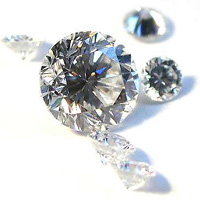Your Online Source for Wholesale Diamonds


A Diamond is the hardest natural material known to man and the third-hardest known material after aggregated diamond nanorods and ultrahard fullerite. Its hardness and high dispersion of light make it useful for industrial applications and jewelry.

Diamonds are specifically renowned as a material with superlative physical qualities, they make excellent abrasives because they can be scratched only by other diamonds, Borazon, ultrahard fullerite, or aggregated diamond nanorods, which also means they hold a polish extremely well and retain their lustre. About 130 million carats (26,000 kg) are mined annually, with a total value of nearly USD $9 billion. About 100,000 kg are synthesized annually.
The name diamond derives from the ancient Greek adamas (αδ?μας "invincible"). They have been treasured as gemstones since their use as religious icons in ancient India and usage in engraving tools also dates to early human history. Popularity of diamonds has risen since the 19th century because of increased supply, improved cutting and polishing techniques, growth in the world economy, and innovative and successful advertising campaigns. They are commonly judged by the "Four C’s": carat, clarity, color, and cut.
Roughly 49% of diamonds originate from central and southern Africa, although significant sources of the mineral have been discovered in Canada, India, Russia, Brazil, and Australia. They are mined from kimberlite and lamproite volcanic pipes, which brought to the surface the diamond crystals from deep in the Earth where the high pressure and temperature enables the formation of the crystals. The mining and distribution of natural diamonds are subjects of frequent controversy such as with concerns over the sale of conflict diamonds by African paramilitary groups. There are also allegations that the De Beers Group misuses its dominance in the industry to control supply and manipulate price via monopolistic practices, although in recent years the company's market share has dropped to below 50%.